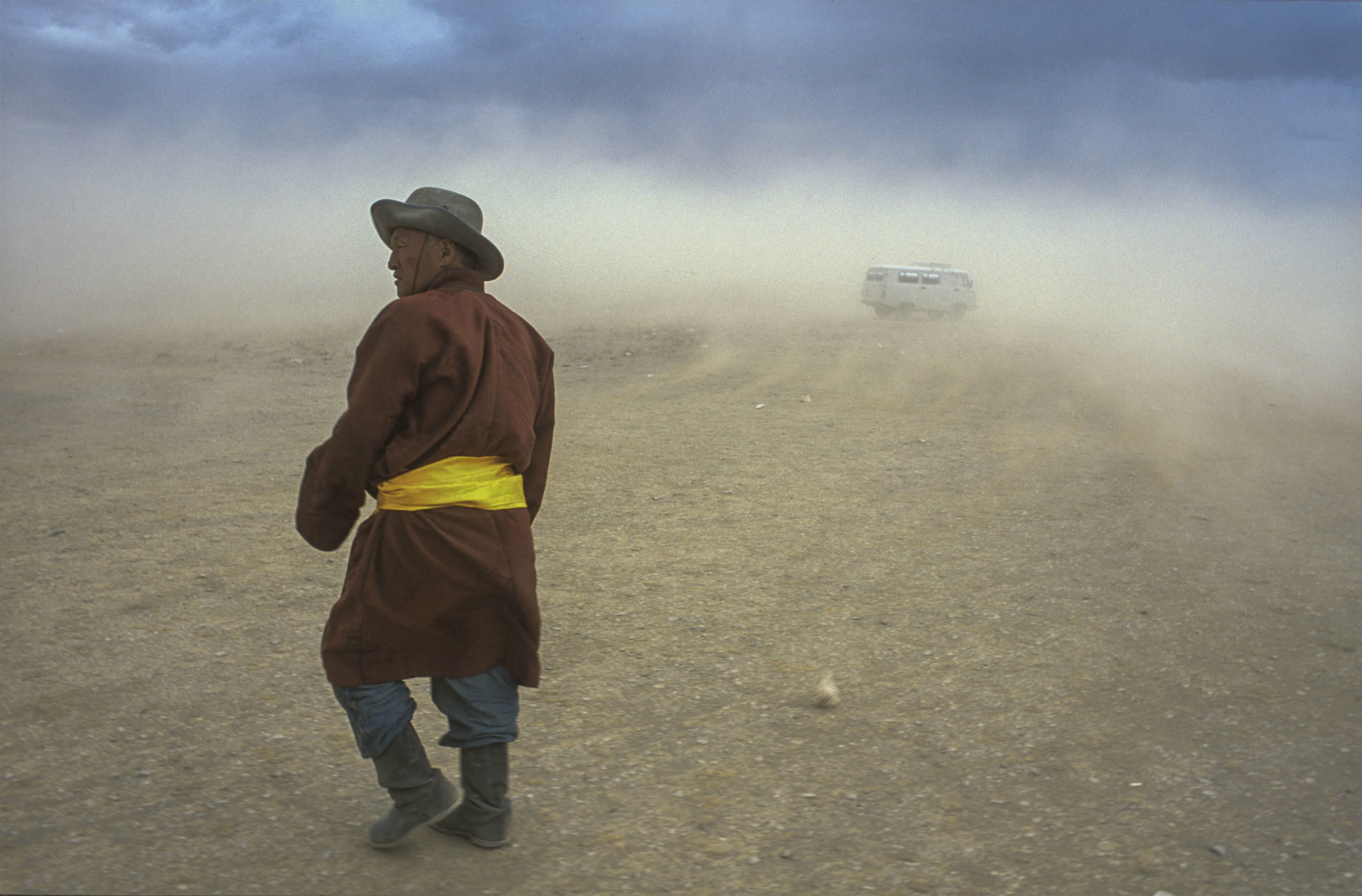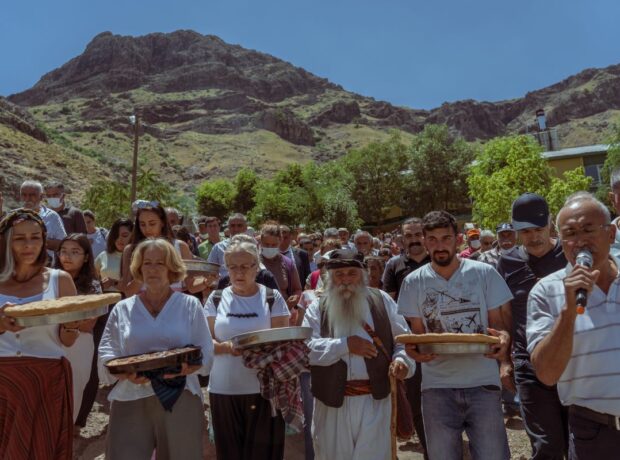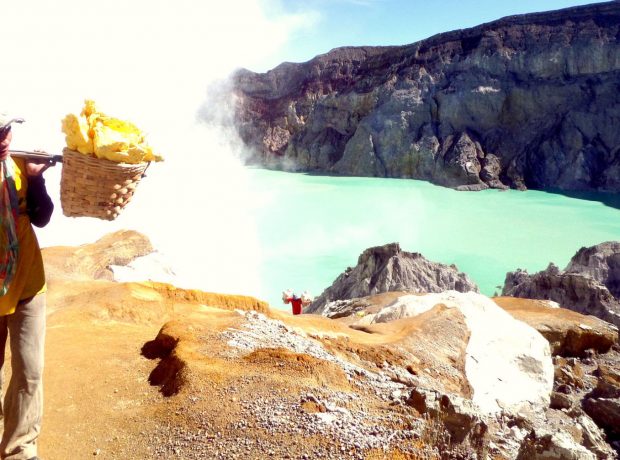Water is power, the consultant whispered to me over a sleek coffee table in central Ulaanbaatar. Everyone knows this in mineral-rich Mongolia, and yet we whisper.
This point sits elephant-esque in the halls of policy-making and policy-advising in the world’s coldest capital, in civil society debates around the country and in the citizen councils of local government. Technology, innovation and multi-stakeholder partnerships are touted as pathways towards sustainable water management. Forums are convened, opinions solicited and the Gobi desert quietly grows, spreading her sandy hands over fourteen hundred new square kilometres every year. She is fast and perhaps furious too, sending billows of biting sand that sticks in the throats of humans and animals.
Pastoralism in a Dynamic Desert Environment
The Gobi desert occupies around 1.3 million square kilometres of the Palearctic eco-region, a ‘transitional zone’ of desert-steppe terrain, where grasslands merge with the Alashan Plateau. A fragile and dynamic environment, the Gobi’s mood is notoriously temperamental. Temperatures can plunge overnight, boasting over thirty degrees Celsius in summer and negative forty degrees in the winter.
For me, nothing encapsulates the Gobi more than its ghost: that wind whose curse and croon echoes on and on, over the steppes, those dunes, the sturdy tussocks, over the heads of the goats, the sheep and the camels.[i] Take the Trans-Siberian rail from Beijing at least as far as Ulaanbaatar and meander through a singular route of the region, from the sand dunes of Sainshand through to the steppe-like prairies of the middle and upper Gobi. Drive out of the towns and stand silent a while and let the horizon disorient your perspective – your citified vision – briefly.
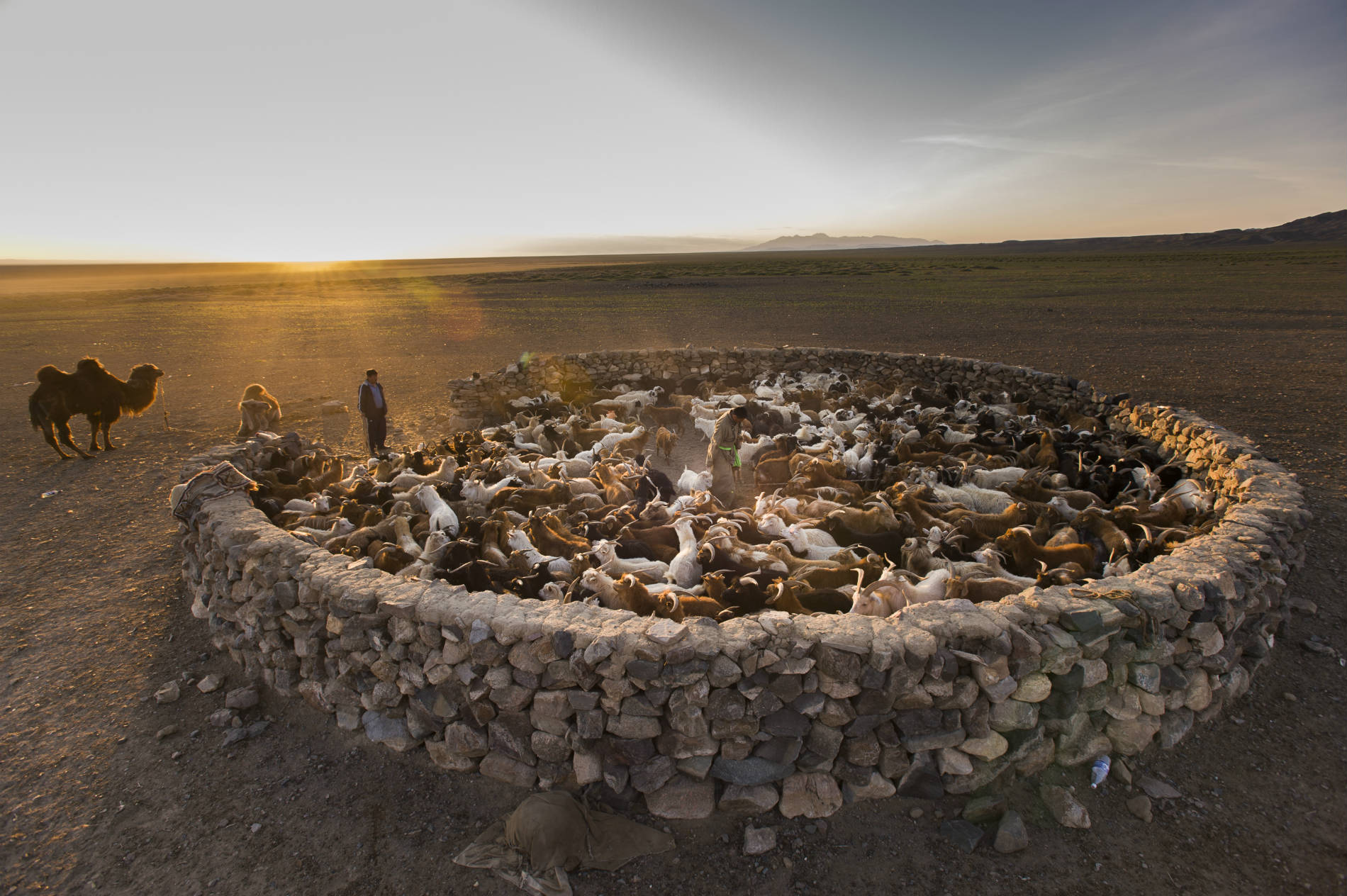
Photo by Sven Zellner
Outer Mongolia exists in the imagination of most visitors as a frontier land, a wilderness. In particular, the Gobi evokes an impression of bleak desolation. But for centuries, semi-nomadic herders have navigated the Gobi’s feisty temperament and found a home there. It is not an easy life, especially if you’re accustomed to urban comforts. Harsh winters bring animals to their knees foraging for the smallest shoots of vegetation deep underneath the snow. The summers don’t always bring enough rain. Herders carefully watch for water levels in wells and streams, and maintain adequate shelters for the winter months. Camels, goats, and sheep – the hardy ones – can survive here, guided to summer and winter pastures. These watchful semi-nomadic movements, like figure-eights on a windswept dance floor, appease the Gobi to continue offering her seemingly endless horizon as a home and dwelling place. There has been hardship and happiness here, like any place, but also life. The green shoots poke their heads up through that desert steppe most summers, new goat kids and baby camels are born here, and little children totter or play-wrestle in front of felt-wrapped gers.
If this appears as a romantic depiction of the landscape, the point being made is a simple one: where there is life, the beautiful and the difficult co-exist. This is to suggest that the Gobi is no empty frontier, nor a wasteland.
where there is life, the beautiful and the difficult co-exist.
Like the rest of Mongolia, the expansive Gobi has played host to a pastoral economy for thousands of years. Pastoral nomadism is not only a socio-cultural system, but an economic one. Pastoralism, as practiced in Mongolia, has gone through many transformations over the centuries, with the most dramatic change concentrated in the past hundred years with the rise and fall of socialism, the advent of democracy and, most recently, a mining boom. Even still, approximately thirty to forty per cent of the Mongolian population are involved to some degree in the pastoral economy. It’s hard to say exactly, given that herders tend to operate within kinship networks, where one relative might run a small shop in an urban centre, while another does the physical herding, and so on.[ii]
Herders in the Gobi have historically been the most mobile, due to their reliance on groundwater and the fragility of the Gobi’s hospitality. Scarce water and foraging resources have been kept in overall balance as a result of this willingness to roam, in conjunction with a diverse herd composition of camels, sheep and goats to prevent overgrazing. The liberalisation of Mongolia’s economy in the early 1990s, however, meant that cashmere – along with copper – became the country’s major export. As herders responded to the “invisible hand” the number of goats soared. Unfortunately, goats have a strong tendency to damage the soil, by viciously removing plant roots when grazing. According to environmental scientists, more goats means the desert-steppe is more likely to permanently transition into a desert in the future.

Photo by Sven Zellner
Extractivism and Investment in the Gobi
While the increase in goats has a proven correlation with the rapid desertification of the Gobi, there is less of a consensus on the impact of mining. Mongolia has exploited a handful of mineral deposits over the past century, but these were nationalised projects designed to industrialise – read: modernise – the country.
Mongolia’s mining strategy since the late 1990s is a different matter. It is the backbone of Mongolia’s new economic development strategy,[iii] which has the intention to globalise – again, read: modernise – Mongolia’s economy so that it is specialised in its comparative advantage: minerals. Current estimates suggest that there is around U.S. $1 trillion worth of minerals spread over six thousand sites, representing eighty different mineral types. Copper, coal, gold, iron, tin, fluorspar, uranium, natural gas and oil all sit beneath the Mongolian earth.
As a case in point, when Robert Friedland of Ivanhoe Mines discovered extensive copper and gold in the Southern Gobi in 2001 – now known as the Oyu Tolgoi deposits – he rejoiced:
There’s no people around, the land is flat, there’s no tropical jungle, there’s no NGOs, [and] we’re only 70 km from the Chinese border… You’ve got lots of room for waste dumps without disrupting the populations and we are building the biggest new mine in the world…Go East or West or South of us, [and] we’d be in China, but we are in a free democratic country, which is the darling of the World Bank, the Asian Development Bank, the EBRD [European Bank for Reconstruction and Development].
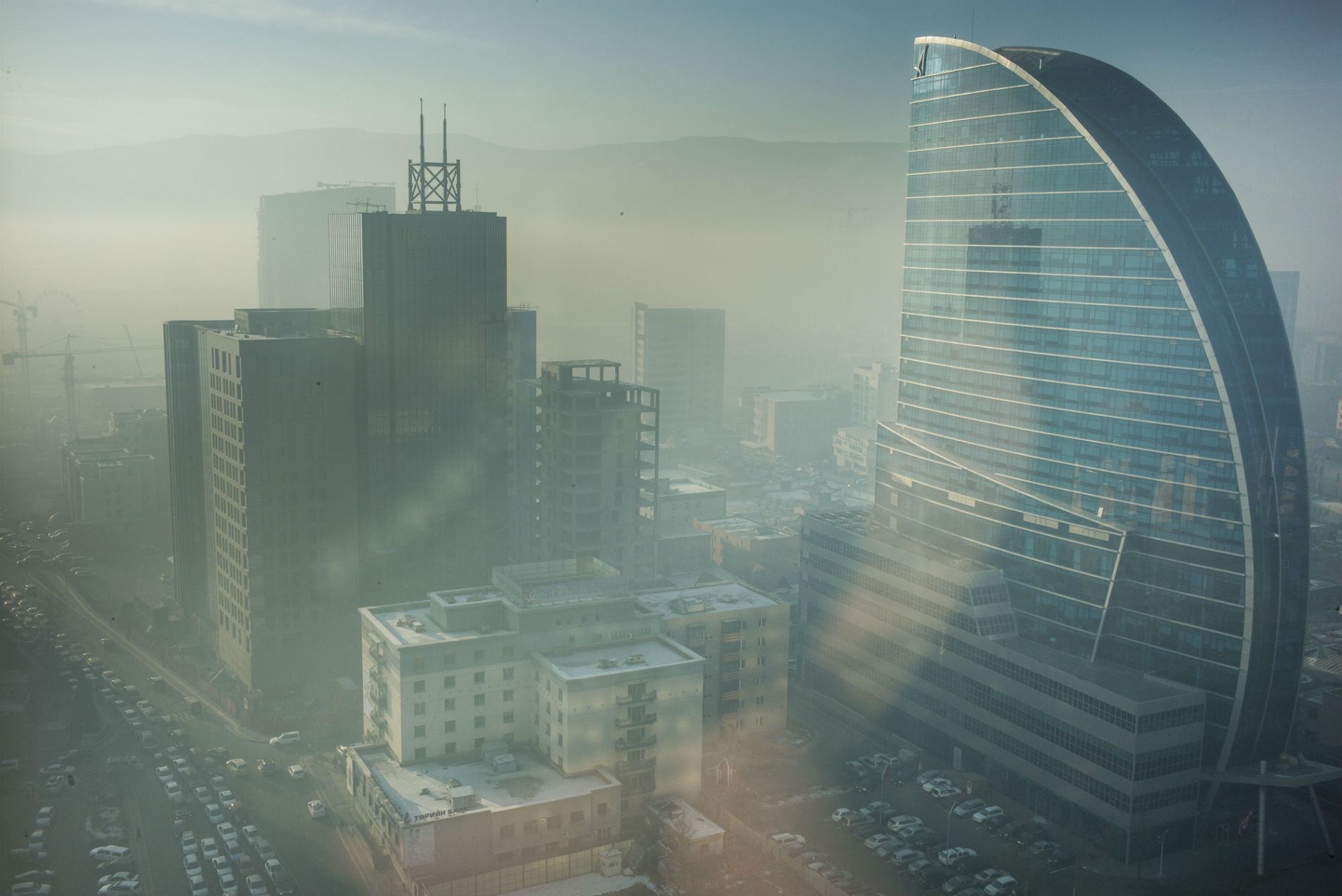
Photo by Sven Zellner
The objective value of the Gobi, in a Friedlandian sense, as it were, lies in its reserves of high-quality copper, gold and coal. The Oyu Tolgoi and Tavan Tolgoi mineral deposits in the Southern Gobi region hold staggering levels of wealth, particularly for a country with the world’s lowest population to land ratio. Tavan Tolgoi is not a new discovery, but China’s voracious thirst for coking coal in recent years, in order to produce steel, makes it a particularly significant deposit for Mongolia. Tavan Tolgoi is also politically volatile. The long and bitter history that lies between China and Mongolia rears its head regularly and the “objective” value of a mineral deposit can be so easily complicated by a little history. The Mongolian government re-nationalised the deposit in 2006 and is currently in the midst of fraught negotiations with private companies from China, Mongolia, Germany, Russia, among others, all of whom are interested in gaining the rights to extract the resource.
However, it seems that Oyu Tolgoi is the mine that has put Mongolia’s Gobi on the map of the global economy. It is one of the World Bank International Finance Corporation’s largest and most complex infrastructure projects. According to a recent Reuters article, Oyu Tolgoi boasts ‘the world’s largest project finance, backed by a large consortium of commercial banks and international financial institutions.’ The area is said to be pregnant with 25 million ounces of gold and 46 billion pounds of copper. Some estimates are considerably higher. In short, Oyu Tolgoi has given Mongolia a golden ticket, almost literally, to the promise of economic growth. In 2009, the Mongolian government entered into a binding, long-term investment agreement with Rio Tinto and Turquoise Hill Resources (formerly Ivanhoe Mines), with plans to commence commercial production in 2013. While there have been some serious hiccups and arm-wrestling over the terms of that production in the media, around board room tables and in the Mongolian parliament, the southern Gobi remains set to become Mongolia’s money tree.
Finding Ninjas in the Shadows
Informal gold-diggers are colloquially termed “ninjas” for their resemblance to Teenage Mutant Ninja Turtles, when they carry their green gold-panning buckets on their backs.In less genial terms, a ninja is defined as ‘a person who mines for gold without possessing the legally required mining license and thereby evades state regulation with regards to taxation, environmental rehabilitation and land entitlement.’[iv]
The bellicose termrightfully associates warfare with the emergence of illegal gold digging in Mongolia: after all, it is a war of interests over land and water use. Sven Zellner’s striking documentary, Price of Gold (2010), highlights the precariousness of illegal digging in the Gobi desert, and the miners’ ambiguous and differentiated experiences of working in the shadows of the extractive economy. In one scene, a herding family that the “ninja” boss meets is clearly struggling to get by, tending a small flock of goats over desolate hills. An elderly woman stirs milk tea on the stove and remarks, “How dry it is all the time. We nomads need the green.” In contrast, the ninja miners are set on finding another colour: gold. Conflict is common between herders and ninjas because of the threat of water pollution caused by the latter’s rudimentary mining techniques, particularly the use of mercury. At the same time, a mutual sense of vulnerability blurs any clear-cut line of conflict that might divide the two groups neatly. Many ninjas are, in fact, former herders. As one miner says: “nothing in fact is more important than a herd. At least you can eat the meat and sell the wool. Prospecting for gold is bad… Nature will definitely take its revenge.”
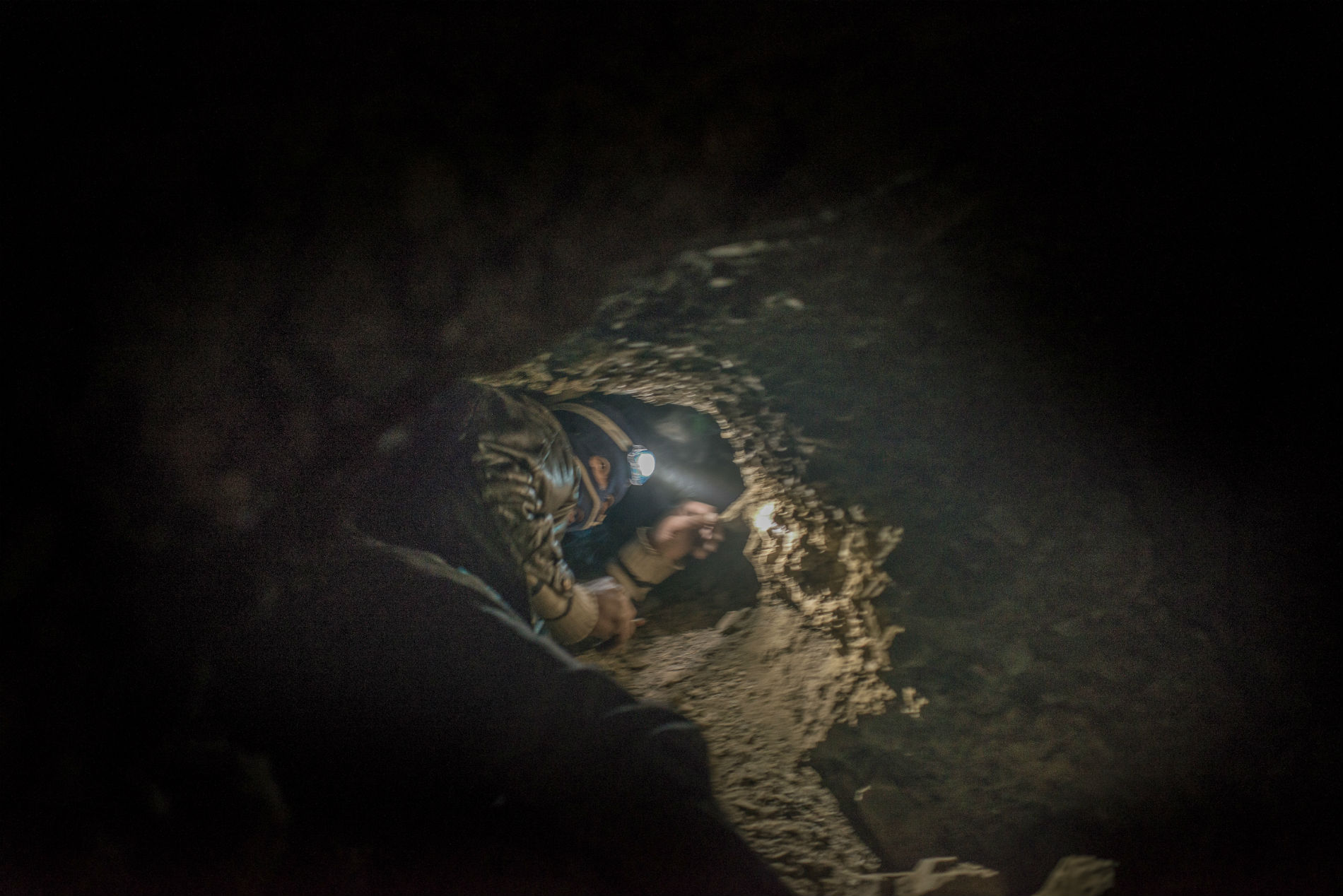
Photo by Sven Zellner
While the work of an illegal gold-digger can be deadly, in reality it lacks the glamour that the title suggests. They do not tend to wear protective gear, lacking the safety aided by hard hats, masks, proper shoes or gloves. Countless lives – literally, uncounted – have been lost. Unregulated artisanal mining, as it is otherwise called, typically involves high risks and low levels of technology in extraction. Globally, this type of mining has exploded as a livelihood in parallel with the expansion of the extractive industry across new mining “frontiers” in South America, Africa and Asia.[v] In Mongolia, it is estimated that artisanal miners constitute well over twenty per cent of the rural working population. The fruits of their precarious labour contribute approximately ten percent of revenue to national coffers.[vi] At the beginning of the mining boom, around the turn of the millennium, the number of ninjas leapt from ten thousand to one hundred thousand in the space of four years.[vii] The phenomenon of ninja mining is linked directly with the boom of formal investment into gold prospecting in the mid- to late nineties under the loose regulatory framework of the Gold Programme and the 1997 Minerals Law.[viii] As most mining companies did not reclaim the land following their exploration, abandoned sites attracted informal diggers searching for leftover gold to process and sell on the black market. Artisanal mining techniques are often hazardous, although interventions have been instigated at the national and international level to lessen the associated risks.
Those on top eat, us here down below don’t. Then we eat from our nature… We want just a handful of soil from the country where we were born and grew up in.
In the Gobi, illegal miners dig deep pits and use dynamite to explore a gold vein. Once the rock or sediment has been exploded, the debris is shovelled to the surface where it is then treated with mercury to bring out the gold. Many ninjas now know of the danger mercury poses to water sources and to human health, but they lack other means or know-how by which to extract the minerals. In 2010, sitting on a hilltop with a Gobi horizon behind him, the boss of an informal mining gang, Ochiroo-akh, explained to Sven Zellner that,
We’re not like foreigners who have eaten up their entire soil. We want our share, forbidden or not. We take what is ours. We defend ourselves. Those on top eat, us here down below don’t. Then we eat from our nature… We want just a handful of soil from the country where we were born and grew up in.
Ochiroo-akh’s words seem to reflect the plight of ninja miners more generally, but Zellner’s documentary, Price of Gold, subtly highlights that different ninjas read their situations through different lenses. Where Ochiroo-akh defends the ninjas’ right to mine almost as a form of resistance to foreign mining companies, a worker, Khuyagaa, expresses a sense of self-contempt:
What’s good about being a gold digger? You use things you shouldn’t use… I don’t want to badmouth myself, but we are digging deep holes. Who will cry for me if the rope suddenly breaks? The poor man died digging for gold. Then it will be forgotten. You’re greedy, destroy your country and nature for money. At least that’s how I think.

Photo by Sven Zellner
For Eegii, another worker, he expresses a lack of choice: ‘What can you do? You have to earn money somehow. And the animals give wool in spring but that’s all.’ On another occasion he laments that, ‘to stay is tough, to go is tough.’
Across Mongolia, people are turning to informal gold mining as a source of income. While for a few it is supplementary, for many it is their only income. Some are poor herders who can no longer make a sufficient living with their herd, some are convicts and ex-prisoners; others used to be employed in service sectors but are now without work. There is no essential identity of a ninja that binds them together. Rather, they are connected through the mutual experience of Mongolia’s profound socio-economic transformation in the 1990s, with the marketization of the economy and the national shift towards export-oriented extractive development. They are, perhaps, better understood as “communities of danger,” to borrow Upendra Baxi’s phrase. The promise of prosperity may be sounding out more and more loudly but the cost of competition is higher, too: there are more interests at stake in the soil. The question remains as to whether the Gobi will – or can – continue to patiently host pastoralism as well as large-scale and artisanal mining.
Building Sand Castles: Water Governance and the Question of Legitimacy
Just how – and when – nature will react is a critical question, particularly when it comes to the sustainability of water in this arid region. The presence of multiple economic interests in the Gobi has brought this question to a head, but the problem of effective water governance persists.
While there is some talk of decentralising decision-making over water use at the provincial level, local governments have recently had some authority taken away from them under the 2012 Water Law. Non-governmental associations are being designed to manage medium levels of water use – basically for mining projects. Large-scale use is managed at the central level. There is talk of decentralisation, but in practice it seems that decision-making has been re-centralised for significant water-related projects.
This might not be all bad news, but it depends upon whether the central government has an accurate awareness of just how water-stressed the Gobi region is. It also depends on whether the central government is more concerned about the country’s flagging economic growth or its long-term environmental sustainability. Of course, idealists suggest that both of these goals can be realised together, but that remains to be seen. For example, one wonders whether plans will go ahead to divert one of Mongolia’s largest rivers, the Orkhon, from the north so as to sustain mining and infrastructure projects in the Gobi. Already, the main river providing surface water to the southern Gobi – the Undai River – has had to be diverted ‘due to the location of the [Oyu Tolgoi] copper resource.’[ix] While a Detailed Environment Impact Assessment (DEIA) has been undertaken by Oyu Tolgoi LLC, local herders have expressed concerns that the promise of creating new water sources from the diversion will be empty. Environmentalists, local residents and some NGOs are very critical of both the Orkhon and Undai River diversions, but, in order to sustain hopes for mining development in the desert-steppe, more water is needed.
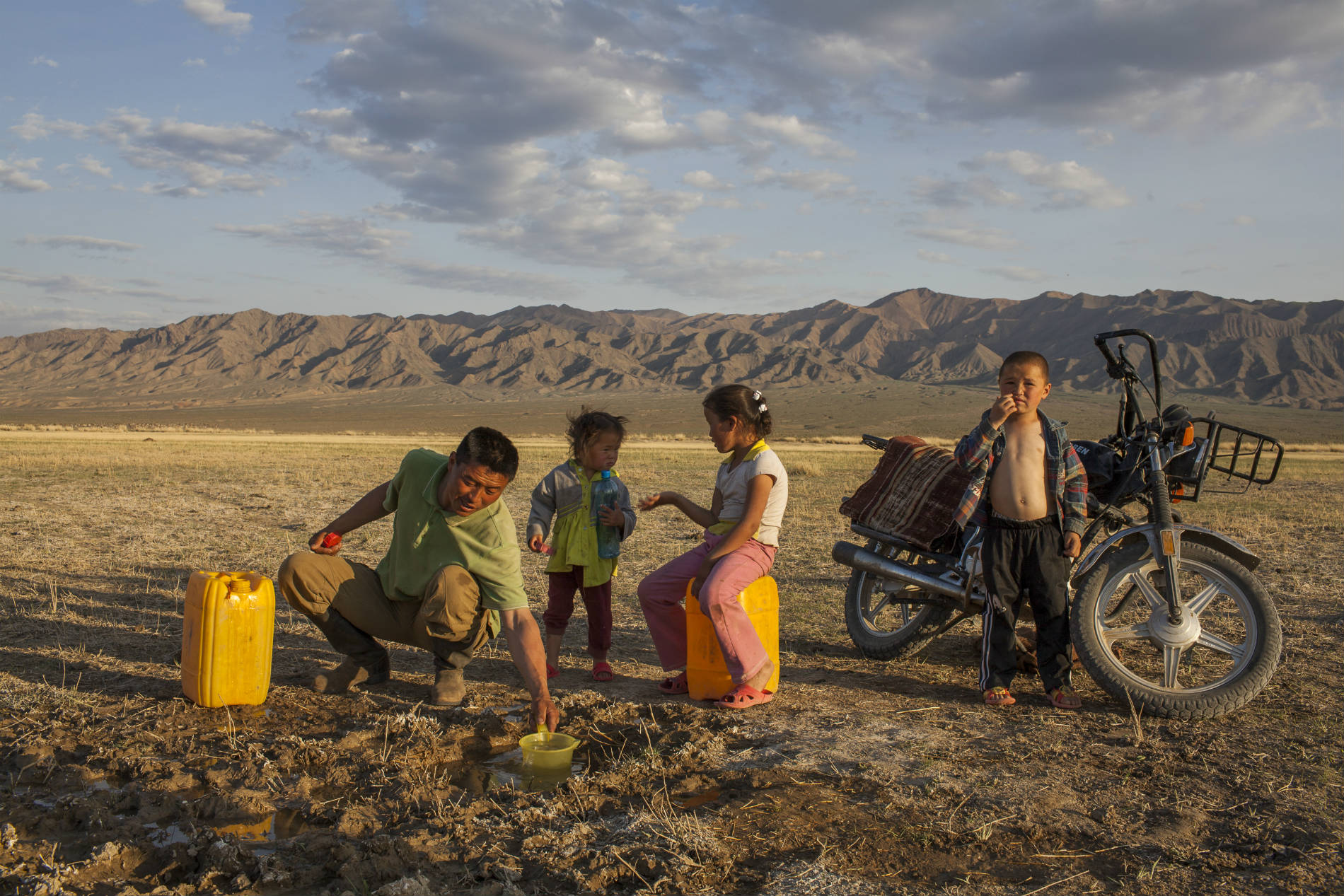
Nomads gathering water, Mongolia
When I visited Mongolia in the autumn last year, I met several geologists, environmental scientists, conservationists and other experts working in the water sector. In our conversations, I mentioned the anxieties herders have had in recent years about the boom of mining interest in the Gobi and the impact on water – groundwater particularly. The environmental impacts of some mining projects are under the microscope, along with water levels in local wells. But the fact of the matter, I was told, is that policymakers and their associated panels of experts – environmental scientists, corporate advisors, consultants, researchers and environmental NGOs – lack concrete data to understand to what degree water levels are impacted by mining. The drying up of wells is commonly attributed to the impact of climate change in the region. Identifying levels of groundwater, meanwhile, is a very expensive process, which requires particular expertise and technology that is difficult to procure in Mongolia. The most cost effective explanation is arguably the one most likely to gain traction.
It is easy to see the impact of mining on water in northern regions of Mongolia where the pollution of rivers is evident. But there is an informational black hole when it comes to water data in the Gobi. Mongolia’s largest mining project, Oyu Tolgoi, has provided quite extensive mapping of water sources in the project area, through their water feasibility studies and Environmental Impact Assessments. While these are strongly contested by some, and cannot compensate for the lack of baseline data in the Gobi as a whole, at least there appears to be a growing dialogue between herders, Oyu Tolgoi LLC, NGOs, and all levels of government concerning water. That noted, the informational fog that hangs over many other mining ventures in the region is potentially even more troubling. The Gobi’s expansive geography and the lesser size of some mining companies means that smaller players do not always have the incentive, or the funding, to fully comply with their environmental obligations. Yet, as the case of Oyu Tolgoi shows, even relatively thorough reporting doesn’t always secure confidence or public trust.
Much as the region is an empirical blind spot, there are three things we do know for certain. The Gobi is a water-stressed region. The mining we see in the region at the moment is but the tip of the iceberg, considering the government’s renewed commitment to extraction. Under the recently amended Minerals Law (2014), thirty-five per cent of Mongolia’s land is now available to be licenced for mining. And, just as the consultant whispered across the coffee table, water is power. To have access to water is to have access to economic sufficiency at the very least, and enormous profits at most. At the moment, though, it looks like decisions concerning the environmental feasibility of water permits for mining projects will have to be made on the hoof – at least until data is more fully collated. Unfortunately, this also jettisons the possibility of developing baseline water data from which to make strategic and informed decisions. One doesn’t have to be a complete cynic to suggest that some interests benefit greatly from the lack of information. Out of sight, out of mind.
In Ulaanbaatar, I heard over and over again the mantra that water, as a resource in need of “effective governance,” needs to be depoliticised. Science, not power, should dictate decision-making, many say. But power relations are embedded in the production of science, in the enforcement of law and in the structure of the economy. Rather than depoliticisation, I would argue instead that decision-making over water in Mongolia hasn’t been politicised enough, and that generating deliberative – and public – dialogue on the matter of Mongolia’s most precious resource is vital. While Mongolia may be considered a major global mineral producer,[x] the development of this extractive trajectory is dependent upon access to water. In the Gobi specifically,water is a make or break resource at all levels of economy and everyone has their interests. The scarcity of water means that, often, multiple economic interests are competing for a stake in the same source. So far water governance has been largely relegated to the sphere of experts, leaving the general public, particularly in remote areas, in a sandstormof confusion about the state of the region’s resources. Consequently, there is not only an empirical knowledge gap regarding water and sustainability, but a deeper question of legitimacy. Even if all the facts about water levels in the Gobi were known, on what basis should decisions be made? Whose economic interests should be prioritised? These are questions that must be faced, and soon: a new surge of extractive development is seemingly just around the corner.
Resource governance without a strong focus on legitimacy is like building castles in the sand. And the Gobi knows better than most: sand castles do not last long here.
[i] Did you know that the Gobi is home to some of the rarest creatures in the world, including the Gobi Brown Bear, the Asian Wild Ass, the Saiga antelope and the Bactrian camel?
[ii] For more information about the history and practice of pastoral nomadism see Sneath, D. (2001) ‘Notions of Rights over Land and the History of Mongolian Pastoralism’ Inner Asia, Vol. 3: 41-58; Fernandez-Gimenez, M. (2006) ‘Land Use and Land Tenure in Mongolia: A Brief History and Current Issues’ USDA Forest Service Proceedings RMRS-P http://www.fs.fed.us/rm/pubs/rmrs_p039/rmrs_p039_030_036.pdf; Jamsranjav, C. (2009) ‘Sustainable Rangeland Management in Mongolia: The Role of Herder Community Institutions’ LRT, Vol 9: http://www.unulrt.is/static/fellows/document/jamsranjav-c.pdf; Humphreys, C. (1978) ‘Pastoral Nomadism in Mongolia: The Role of Herdsmen’s Cooperatives in the National Economy’ Development and Change, Vol. 9: 133-160.
[iii] Officially known as the “Millennium Development Goals-Based Comprehensive National Development Strategy 2007-2021” which you can find at http://mofa.gov.mn/coordination/images/stories/resource_docs/nds_approved_eng.pdf
[iv] High, M, ‘Wealth and Envy in the Mongolian Gold Mines,’ Cambridge Anthropology, Vol. 27, No. 3 (2008): 2.
[v] Ibid.
[vi] Hatcher, P. Regimes of Risk. (Online: Palgrave Macmillan, 2014): 117.
[vii] Grayson, R. et al., ‘The People’s Gold Rush in Mongolia: The Rise of the Ninja Phenomenon,’ World Placer Journal, Vol. 4 (2004).
[viii] 80-90% of ninja miners are thought to dig for gold, although a minority also mine for coal and fluorspar. See Cristina Villegas, ‘Ninja Miners and Rural Change in Mongolia,’ ASM-PACE Guest Blog Series 2013. http://www.asm-pace.org/blog/item/11-ninja-miners-and-rural-change-in-mongolia.html
[ix] Oyu Tolgoi LLC. ‘Undai River Protection Project.’ (Online, 2015) http://ot.mn/en/feedback-esia/undai-river-protection-project
[x] Mongolia is now considered to be one of the world’s ‘key producers’ of minerals and was ranked 7th in terms of mineral and ore production in a 2012 study (Hatcher, 2014: 102; Mendoza et al, 2012) See Chapter 4 in Hatcher, P. Regimes of Risk. (Online: Palgrave Macmillan, 2014) and Mendoza et al. ‘Extractive Industries, Children and Inclusive Growth: An Analysis of Mongolia, Papua New Guinea and Timor-Leste.’ Working paper prepared for UNICEF (January 2012).
